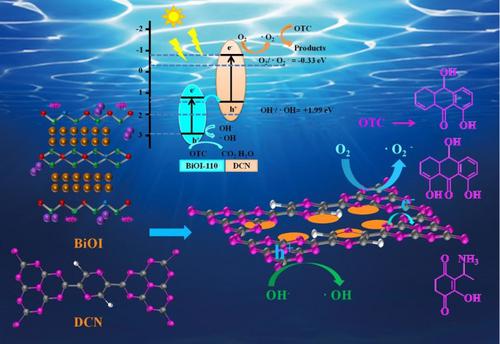Frontiers of Chemical Science and Engineering ( IF 4.5 ) Pub Date : 2021-12-14 , DOI: 10.1007/s11705-021-2116-0 Jianxin Chen 1, 2 , Yupeng Li 1 , Jihui Li 1, 2 , Jian Han 1, 2 , Guijun Zhu 1 , Liang Ren 1

|
Crystalline materials with specific facet atomic arrangements and crystal facet structures exhibit unique functions according to their facet effects, quantum size effects and physical and chemical properties. In this study, a novel high-exposure (110) facet of bismuth oxyiodide (BiOI) was prepared (denoted as BiOI-110), and designed as nanosheets rich in oxygen vacancies by crystal facet design and regulation. Graphitic carbon nitride was designed as curved carbon nitride with dibromopyrazine, denoted as DCN, which contributed to a significant structural distortion in plane symmetry and improved the separation of charge carriers. Novel heterostructured BiOI-110/DCN nanosheets with a high-exposure (110) facet and abundant oxygen vacancies were successfully designed to enhance the photocatalytic degradation of organic pollutants. It was demonstrated that complete and tight contact between BiOI-110 and DCN was achieved by changing the size and crystal facet of BiOI. Oxytetracycline (OTC) and methyl blue dyes were used as targets for pollutant degradation, and 85.6% and 96.5% photocatalytic degradation efficiencies, respectively, were observed in the optimal proportion of 7% BiOI-110/DCN. The experimental results and electron spin resonance analysis showed that •O2− and h+ played a major role in the process of pollutant degradation. Additionally, high-resolution liquid chromatography-mass spectrography was used to identify the reaction intermediates of OTC, and the possible degradation pathway of this pollutant was proposed. Finally, the excellent reusability of BiOI-110/DCN nanomaterials was confirmed, providing a new approach for the removal of antibiotics that are difficult to biodegrade. Overall, crystal facet design has been proven to have broad prospects in improving the water environment.
中文翻译:

在弯曲的氮化碳上具有高度暴露的(110)面的氧碘化铋的晶体设计,用于光催化降解废水中的污染物
具有特定晶面原子排列和晶面结构的晶体材料根据它们的晶面效应、量子尺寸效应和物理和化学性质表现出独特的功能。在这项研究中,制备了一种新型的碘化铋 (BiOI) 的高暴露 (110) 晶面(表示为 BiOI-110),并通过晶面设计和调控将其设计为富含氧空位的纳米片。石墨氮化碳被设计为带有二溴吡嗪的弯曲氮化碳,表示为 DCN,这有助于平面对称性的显着结构畸变并改善电荷载流子的分离。具有高曝光 (110) 面和丰富氧空位的新型异质结构 BiOI-110/DCN 纳米片被成功设计用于增强有机污染物的光催化降解。结果表明,通过改变 BiOI 的尺寸和晶面,可以实现 BiOI-110 和 DCN 之间的完全紧密接触。土霉素 (OTC) 和甲基蓝染料被用作污染物降解的目标,在 7% BiOI-110/DCN 的最佳比例下,分别观察到 85.6% 和 96.5% 的光催化降解效率。实验结果和电子自旋共振分析表明•O2 -和 h +在污染物降解过程中起主要作用。此外,采用高分辨液相色谱-质谱联用技术鉴定了OTC的反应中间体,并提出了该污染物可能的降解途径。最后,证实了BiOI-110/DCN纳米材料优异的可重复使用性,为去除难以生物降解的抗生素提供了一种新方法。总体而言,晶面设计已被证明在改善水环境方面具有广阔的前景。


























 京公网安备 11010802027423号
京公网安备 11010802027423号